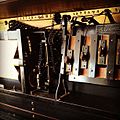Vacuum motor
A vacuum motor , commonly called flame -eater, flame-licker, flame-dancer, is a hot-air motor, but in contrast to the Stirling motor , it is an open system (thermodynamics) . From a technical point of view, it is an atmospheric engine, as the external air pressure does the work here (comparable to the first Otto engine ). As a result, the maximum piston force is limited to the product of the piston area and the air pressure.
Applications
- Model engines as demonstration objects (desk toys)
- Vacuum motor on the automatic piano
- Windshield wipers between 1920 and 1960 - the vacuum used was the suction negative pressure of the combustion engine
- Turntables in the UK taking advantage of the vacuum of the suction air brake
Flame Eaters
The running noise of the engine is caused by sucking in the flame burning in front of the cylinder (external combustion, working medium: hot air) and then expelling the cooled air. Waste heat is given off to the ambient air via the cooling fins of the cylinder. The gas exchange takes place in both directions via the inlet valve , although there are also types with a separate outlet valve. The inlet valve is usually controlled via a cam . If there is an outlet valve, it opens automatically when there is excess pressure. As functional model engines, they are often built as stationary engines in horizontal and vertical versions, as well as single, double or multi-cylinder. They have already been used successfully in models of nostalgic tractors and in rail vehicles .
Only when the piston moves from the maximum displacement to the medium displacement is work performed with the aid of the negative pressure created by the cooling of the flame gases. The valve is open for all other movements of the piston.
Vacuum motors are not self-starting, even multi-cylinder models are not. Similar to the Stirling engine, a flywheel is required to overcome the dead center .
Vacuum motor on the automatic piano
There are also vacuum motors without heat-energy conversion, which use only the pressure difference from the ambient air by means of another type: When reproduction of piano ( Pianola ) of the feed of the Papierloch- is touch roll effected by a three-cylinder-vacuum engine, the crank pins are offset by 120 degrees to always to find a clear direction of travel.
The vacuum is created with a bellows . The bellows, in turn, is operated either manually (with the pianolist's feet ) or by a motor.
Individual evidence
- ↑ a b http://www.pianola.com/airmotor.htm
- ↑ http://www.ehow.co.uk/how-does_5010098_vacuum-windshield-wipers-work.html
- ↑ http://www.ply33.com/Repair/wiper
- ↑ https://www.youtube.com/watch?v=vIDV8tlGjtk
- ↑ https://www.svrtrust.org.uk/index.php?page=Kidderminster%20Turntable
- ↑ https://www.svrwiki.com/Kidderminster_Turntable
- ↑ http://www.gilesdarling.me.uk/pianola/howpianolaswork.shtml#Motor
- ↑ http://www.gilesdarling.me.uk/pianola/howpianolaswork.shtml#Pedals
- ↑ http://www.technikum29.de/en/devices/functional-explanation-pianola
- ↑ http://www.technikum29.de/de/geraete/pianola-funktionserklaerung/
- ↑ http://www.pianola.org/history/history.cfm














